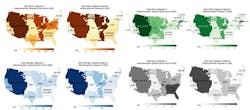The Energy Transition Bottleneck: Berkeley National Lab report shows Interconnection Queue is SSS-Slow
Renewable energy and battery storage developers, spurred by customers’ desires for decarbonization and, not insignificantly, the financial incentives of Biden era legislation, are hopeful to install as much as 1,260 GW (or more than one million MWs) of zero-carbon energy in the U.S. in coming years.
Yet the sheer volume and pace of this energy transition moves are causing long-term interconnection delays as utilities and regional grid operators try to handle the incoming solar, wind, battery storage and microgrid futures, according to a new report from the Lawrence Berkeley National Laboratory.
Indeed, the recent and not-so-recent history of new energy projects tells us that they are in for the long haul before ever generating out into the grid, the Berkeley data shows. Of the projects requesting interconnection in the first 17 years of the 21st century, only 21 percent reached commercial operations by the end of last year, according to the report.
“Completion rates are even lower for wind (20 percent) and solar (14 percent),” the national lab report reads. “The average time projects spent in queues before being built has increased markedly. The typical project built in 2022 took five years from the interconnection request to commercial operations, compared to three years in 2015 and two years in 2008.”
The Berkeley National Lab came to its conclusion using interconnection data from seven of the nation’s independent system operators (ISOs) and regional transmission organizations (RTOs), as well as utilities which represent more than 85 percent of U.S. electricity load. Those RTOs and ISOs nationally include the PJM Interconnection, Midwest Independent System Operator, Southwest Power Pool, California Independent System Operator, Electric Reliability Corporation of Texas and ISO-New England.
Any power system which chooses to interconnect and integrate with the larger grid must file an interconnection request and enter the queue. Once feasibility and system impact studies are done, and if the project isn’t withdrawn (which happens more than not) an agreement is forged and eventually the plant is built and goes into commercial operation.
All of this means that some, if not many, of the major announcements of renewable energy projects will never see the light of day. The investments involved are too large to wait that long for return.
And yet many will be completed and interconnected. The pressure is building, too, because the Biden Administration is not alone in seeking a dramatic shift in power generation emissions to combat climate change. Many companies, investors and governments are on board with this demand for decarbonization.
"The clean energy revolution is going to bring so much more than just better air quality and cheaper utility bills,” U.S. Energy Secretary Jennifer Grantholm said years ago in taking her office. “Over the next two decades, the world is going to invest trillions in electric cars, batteries, wind turbines, solar panels, energy-efficient appliances, weatherized grid infrastructure…the list goes on.”
Indeed. Many of the new zero-carbon energy requests include hybrid solar and storage projects, such as on-site power and islandable microgrids, according to the national lab’s report. And the pace is quickening exponentially, with some 700 GW of capacity making interconnection requests last year alone, the Berkeley Lab says.
Currently, some 2,000 GW, or 2 terawatts, of generation and storage capacity are active in the interconnection queues. Solar energy projects account for nearly 1 TW (947 GW) of those prospective projects, while energy storage is nearly 700 GW, according to the report.
Stunningly, the amount of prospective new energy projects in the queue, at 2 TW, is about 60 percent larger than the entire U.S. power plant current installed capacity at about 1.25 TW (1,250 GW), the report shows.
The maturation of decrees such as U.S. Federal Energy Regulatory Commission’s Order 2222, requiring the inclusion of aggregated distributed energy resources (DERs) into wholesale competitive markets, may even lengthen that waiting list over time.
About the Author
EnergyTech Staff
Rod Walton is senior editor for EnergyTech.com. He has spent 17 years covering the energy industry as a newspaper and trade journalist.
Walton formerly was energy writer and business editor at the Tulsa World. Later, he spent six years covering the electricity power sector for Pennwell and Clarion Events. He joined Endeavor and EnergyTech in November 2021.
He can be reached at [email protected].
EnergyTech is focused on the mission critical and large-scale energy users and their sustainability and resiliency goals. These include the commercial and industrial sectors, as well as the military, universities, data centers and microgrids.
Many large-scale energy users such as Fortune 500 companies, and mission-critical users such as military bases, universities, healthcare facilities, public safety and data centers, shifting their energy priorities to reach net-zero carbon goals within the coming decades. These include plans for renewable energy power purchase agreements, but also on-site resiliency projects such as microgrids, combined heat and power, rooftop solar, energy storage, digitalization and building efficiency upgrades.
